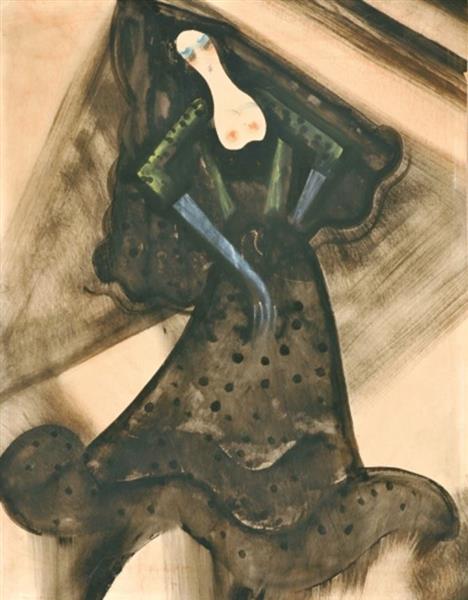Description
The work "Hölgy Fekete Pöttyös Ruhaban" (Lady with black polkhand) by Hugó Scheiber is an outstanding example of Hungarian art of the early twentieth century, a period in which the influence of impressionism and posterior currents such as modernism and Post -impressionism began to permeate artistic production in the region. Scheiber, born in 1873, was a painter who left a significant footprint in the artistic scene of his time, characterized by a technique that fuses the rigor of drawing with the vivacity of color.
In this painting, the central character is an elegantly dressed woman with a remarkable black dressed dotted with white moles, which has become the most distinctive element of the work. The figure of the woman is in an environment not entirely defined, which makes her presence perceive with a strong emotional burden. The composition is balanced, with the central figure occupying a prominent place on the canvas, which allows the viewer to focus his attention on the dress and the expression of the lady's face.
The use of color in this work is particularly interesting. The Scheiber palette is composed of dark and neutral tones that contrast with the white luminous lunar, creating a striking visual effect. The shadows in the woman's skin are subtle and give life to her figure, while the background presents a nuance that could be interpreted as an attempt to keep the viewer in an abstract space, where the woman is the reference point. This choice of colors suggests a curious tension between elegance and introspection; The woman seems trapped in her thoughts, as if she contemplated a reality that goes beyond the mere surface.
Scheiber's style, which can be framed within the slope of modern art, also reflects a connection with the tradition of the portrait, although this work is distinguished by its almost sculptural approach to the female figure. Often, the artist was interested in exploring the psychology of his subjects, transmitting not only the appearance, but also a deeper feeling, what is manifested in the enigmatic expression of the woman whose face is delicately modeling, attracting the viewer to wonder about his hidden thoughts and emotions.
The cultural context in which the work is located is essential to understand its meaning. During the time it was created, Hungary was immersed in social and political changes; The empowerment of women began to collect prominence, and this representation of the female figure can be interpreted as a symbol of autonomy and modernity. Scheiber's work is at the intersection of tradition and modernity, reflecting not only the aesthetics of his time, but also the tensions inherent to the social transformations that were underway.
In summary, "Hölgy Fekete Pöttyös Ruhaban" is more than a simple portrait; It is an exploration of the female figure in the context of a period of transition and change. Scheiber's mastery in manipulation of color and shape, along with their ability to infuse its characters with psychological depth, make this painting a relevant work within the Canon of Modern Hungarian art. In the constant dialogue between the figure and the environment, between tradition and innovation, Scheiber presents not only an image, but a story that invites contemplation and reflection.
KUADROS ©, a famous paint on your wall.
Hand-made oil painting reproductions, with the quality of professional artists and the distinctive seal of KUADROS ©.
Art reproduction service with satisfaction guarantee. If you are not completely satisfied with the replica of your painting, we refund your money 100%.

